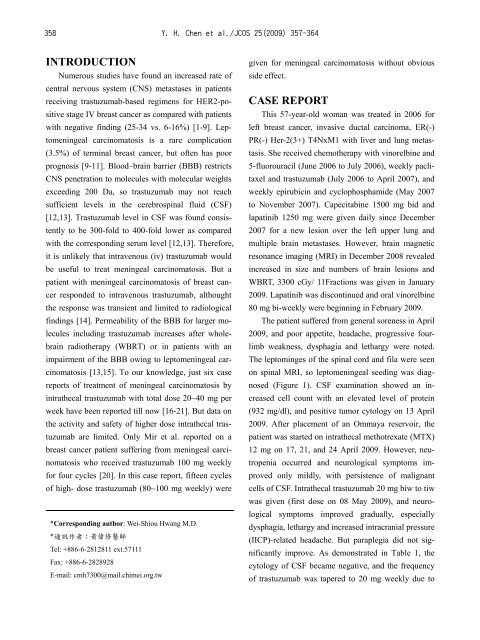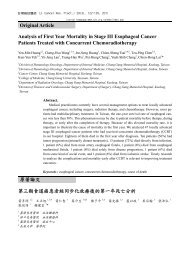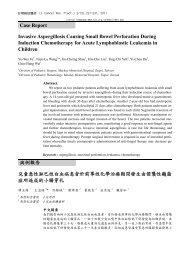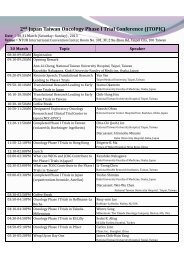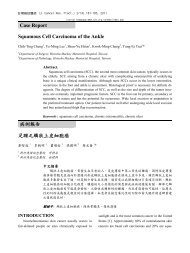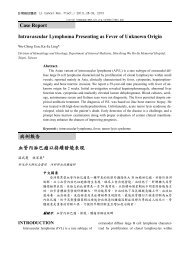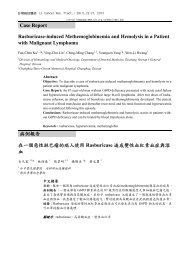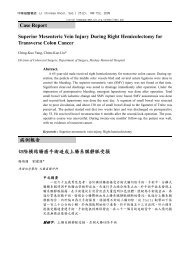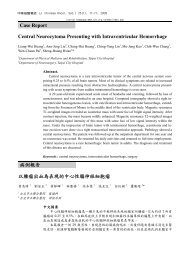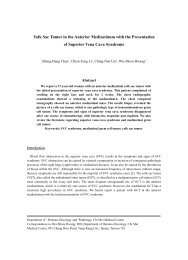Case Report Intrathecal Trastuzumab for Meningeal Carcinomatosis ...
Case Report Intrathecal Trastuzumab for Meningeal Carcinomatosis ...
Case Report Intrathecal Trastuzumab for Meningeal Carcinomatosis ...
Create successful ePaper yourself
Turn your PDF publications into a flip-book with our unique Google optimized e-Paper software.
358 Y. H. Chen et al./JCOS 25(2009) 357-364INTRODUCTIONNumerous studies have found an increased rate ofcentral nervous system (CNS) metastases in patientsreceiving trastuzumab-based regimens <strong>for</strong> HER2-positivestage IV breast cancer as compared with patientswith negative finding (25-34 vs. 6-16%) [1-9]. Leptomeningealcarcinomatosis is a rare complication(3.5%) of terminal breast cancer, but often has poorprognosis [9-11]. Blood–brain barrier (BBB) restrictsCNS penetration to molecules with molecular weightsexceeding 200 Da, so trastuzumab may not reachsufficient levels in the cerebrospinal fluid (CSF)[12,13]. <strong>Trastuzumab</strong> level in CSF was found consistentlyto be 300-fold to 400-fold lower as comparedwith the corresponding serum level [12,13]. There<strong>for</strong>e,it is unlikely that intravenous (iv) trastuzumab wouldbe useful to treat meningeal carcinomatosis. But apatient with meningeal carcinomatosis of breast cancerresponded to intravenous trastuzumab, althoughtthe response was transient and limited to radiologicalfindings [14]. Permeability of the BBB <strong>for</strong> larger moleculesincluding trastuzumab increases after wholebrainradiotherapy (WBRT) or in patients with animpairment of the BBB owing to leptomeningeal carcinomatosis[13,15]. To our knowledge, just six casereports of treatment of meningeal carcinomatosis byintrathecal trastuzumab with total dose 20~40 mg perweek have been reported till now [16-21]. But data onthe activity and safety of higher dose intrathecal trastuzumabare limited. Only Mir et al. reported on abreast cancer patient suffering from meningeal carcinomatosiswho received trastuzumab 100 mg weekly<strong>for</strong> four cycles [20]. In this case report, fifteen cyclesof high- dose trastuzumab (80~100 mg weekly) were*Corresponding author: Wei-Shiou Hwang M.D.* 通 訊 作 者 : 黃 偉 修 醫 師Tel: +886-6-2812811 ext.57111Fax: +886-6-2828928E-mail: cmh7300@mail.chimei.org.twgiven <strong>for</strong> meningeal carcinomatosis without obviousside effect.CASE REPORTThis 57-year-old woman was treated in 2006 <strong>for</strong>left breast cancer, invasive ductal carcinoma, ER(-)PR(-) Her-2(3+) T4NxM1 with liver and lung metastasis.She received chemotherapy with vinorelbine and5-fluorouracil (June 2006 to July 2006), weekly paclitaxeland trastuzumab (July 2006 to April 2007), andweekly epirubicin and cyclophosphamide (May 2007to November 2007). Capecitabine 1500 mg bid andlapatinib 1250 mg were given daily since December2007 <strong>for</strong> a new lesion over the left upper lung andmultiple brain metastases. However, brain magneticresonance imaging (MRI) in December 2008 revealedincreased in size and numbers of brain lesions andWBRT, 3300 cGy/ 11Fractions was given in January2009. Lapatinib was discontinued and oral vinorelbine80 mg bi-weekly were beginning in February 2009.The patient suffered from general soreness in April2009, and poor appetite, headache, progressive fourlimbweakness, dysphagia and lethargy were noted.The leptominges of the spinal cord and fila were seenon spinal MRI, so leptomeningeal seeding was diagnosed(Figure 1). CSF examination showed an increasedcell count with an elevated level of protein(932 mg/dl), and positive tumor cytology on 13 April2009. After placement of an Ommaya reservoir, thepatient was started on intrathecal methotrexate (MTX)12 mg on 17, 21, and 24 April 2009. However, neutropeniaoccurred and neurological symptoms improvedonly mildly, with persistence of malignantcells of CSF. <strong>Intrathecal</strong> trastuzumab 20 mg biw to tiwwas given (first dose on 08 May 2009), and neurologicalsymptoms improved gradually, especiallydysphagia, lethargy and increased intracranial pressure(IICP)-related headache. But paraplegia did not significantlyimprove. As demonstrated in Table 1, thecytology of CSF became negative, and the frequencyof trastuzumab was tapered to 20 mg weekly due to


